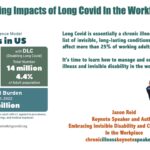February 3, 2022 – Quote: “In lieu of actual information, people will create their own stories…that’s just human nature.” Jason Reid Chronic illness and invisible disabilities are serious topics, and I think we all know someone who has been inflicted by one or the other. Government statistics show one in three working-aged adults has at least one […]
Continue readingShort Timeline of Workplace Resources around Invisible Disabilities
Published on Linkedin August 23rd, 2023 This summer I have been extremely heartend by the significant number of organizations reaching out to me to speak about invisible disability, mental health and neurodiversity in the workplace. As someone who not only speaks about invisible disabilities, but who has also dealt with the same issues in a […]
Continue readingHow to Deal with Long Covid in the Workplace (video)
Potential increase in disability leave, presenteeism, as well as recruitment and retention issues. For some people, COVID 19 can cause symptoms that last months or even years after the original infection, this is called LONG COVID Studies suggest that long covid affects between 10 to 30 percent of infected people. In the U.S. alone it […]
Continue readingInvisible Disability – The Trillion Dollar Problem.
More than a trillion dollars. That’s how much chronic illnesses and invisible disabilities cost organizations in the United States in 2007. These numbers are expected to quadruple by 2030. A trillion dollars makes the mind boggle. That’s a million million. With that amount of money, you could pay all of the rent cheques in the United States for three years! […]
Continue reading

